Review by Lutz Bendlin
Introduction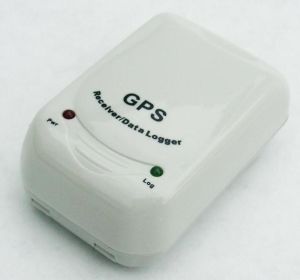
GPS data logging has always been an interesting topic. After many attempts we finally managed to secure some review gear that is very different from the average GPS receivers we review.
In fact, we will be able to review two special devices, and we'll therefore make this a two part reviw.
First up is the "WorldTracker Data Logger" by Security Concepts (Special thanks to Gilbert Walz for making this possible).
What's so special about these receivers? Well, they are marketed as tools for tracking cars and people, mostly without knowledge of the tracked subject. So basically they are spy toys, or investigation assistance devices if you are with the police.
The review unit has only a USB connector, but Security Concepts will soon add a similar Bluetooth unit.
What's in the box?
 You've got You've got
- the receiver
- a CD with the WorldTracker program and the Windows USB driver (standard Prolific PL2303)
- the USB cable (not shown in the picture)- this is not a standard mini USB version but rather the micro USB as found on some digital cameras
- a car charger adapter with USB(A) receptacle
- and some very very fancy mounting solution involving a soap box and a few suction cups. More about that later.
The CD contains the aforementioned WorldTracker program, the USB driver, and some video tutorials that give you a brief but useful introduction into the general use of this setup.
The receiver comes with three rechargeable 1.2V NiMH AAA batteries, but you can also use standard 1.5V AAA batteries as shown here. Battery runtime varies with the amount of logging done, and is in the range of 10 to 18 hours.

The receiver (and especially the battery compartment) is not completely watertight. I would have expected that for the covert operations this would be a must-have requirement. Have your ziploc bag ready.
The receiver can also be wired into the car's electricity network (works without the batteries) but that may draw current and the attention of your suspect...
A walk around the receiver
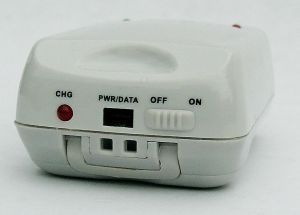 The receiver looks pretty, uhm, interesting. The plastic is kind of egg shell dark grey, the body is ultra sonic welded (making it impossible for us to peek inside) and feels more like a medical device. The receiver looks pretty, uhm, interesting. The plastic is kind of egg shell dark grey, the body is ultra sonic welded (making it impossible for us to peek inside) and feels more like a medical device.
On the other hand it is not supposed to be shown around but rather tucked away somewhere, possibly even without the tracking target knowing about it.
If you see it from that angle you do actually wonder why they printed the purpose of the device onto the cover, and why the red power LED is so bright when the unit is on...
On the top you've got the power and log LEDs. The power LED blinks when the juice is low, the log LED blinks when an entry is written to the log.
On the side you have the charge indicator (obviously not important when you use alkaline batteries), the micro USB connector for power and data, the on/off switch, a lanyard thingie, and the lever for the battery compartment.
That's about it, no option to connect an external antenna, and no indication of a GPS fix.
Speaking of GPS - the WorldTracker employs a pretty exotic chipset - Furuno - that claims to be equivalent to SiRF III. Furuno are a japanese company that is very big in marine electronics, and also seems to have a good share of the japanese GPS market.
The Furuno chip has 16 channels with 16 correlators each, and the marketing blurb says that due to this a cold fix takes only 48 seconds. I could not verify that since there is no fix indicator on the device, and no obvious way to do a factory reset.
On thing is clear - the chip is better than SiRF II, but has no chance when compared to a SiRF III. I wonder what happens if you attach the device to the bottom of the car you want to track. We are talking about covert tracking after all...
Software setup
To connect the receiver to your PC you first need to install the USB Serial emulator driver. You may have that one already if you use other USB serial devices.

To do that, pop the CD in and connect the receiver to the PC via the USB cable. After pointing the installer to the CD folder witht he PL2303 driver you will end up with an additional COM port.

Now you can use the receiver with any PC navigation program. But since this is a tracking device let's install the tracking program "WorldTracker". The CD also comes with some nifty video tutorials that give a very good introduction into the basics of the operation (so to speak :-).
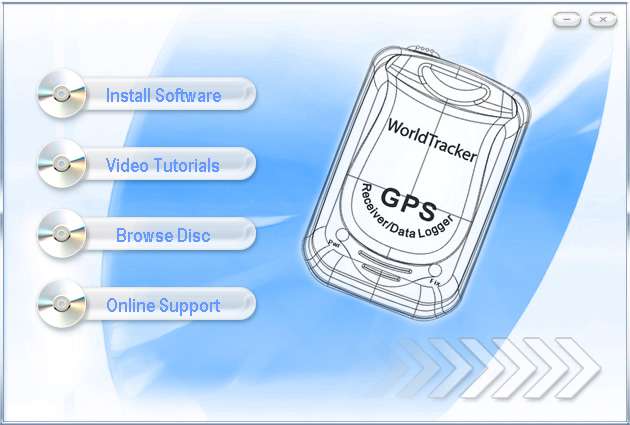
Alright, ready to go. To enable logging we have to connect the receiver and chose the speed that will trigger logging. Let's say you want to track all movement above 5 mph - for that you specify

and then select
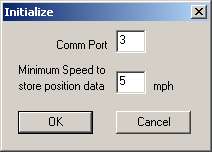
What this will give you is a data log entry every ten seconds IF the speed of the device is at or above 5 mph. If the speed is below that then no log entry is recorded.
What's a good speed to select? Anything that allows to tell between the natural GPS deviation ( the hopping around of your GPS position even if you are stationary) and the real movement of your target. If you are spying on a pedestrian you'll probably want to set the limit at 1 mph.
You can also specify 0 mph - in that case the receiver will simply log the position every ten seconds.
Each log entry will basically be the RMC line at the time of measurement, giving you position, speed, heading, and timestamp.
$GPRMC,012440,A,3305.3670,N,10333.1607,W,000.0,246.3,071205,004.1,E,A*01
Oddly there doesn't seem to be an option to select a different time interval - ten seconds is a pretty long time and a lot can happen in that interval. Data Logger Capacity
This is the part I love about the receiver. The website states you can log 100.000 data points. Can this be true?
On the data sheet it says the receiver has a 8 MB circular buffer (this means when the buffer is full the oldest entries get overwritten).
A typical RMC entry is 72 bytes long, let's add two bytes for the carriage return and line feed characters.
8 x 1024 x 1024 / 74 = 113359.57
So, give and take, we are talking 113.359 data points! If you keep the receiver permanently powered (and your tracking subject doesn't notice or doesn't mind) you're good for at least 314 hours of tracking!
Track visualization
Now you have collected all that nice data, and want to do something with it. Connect the receiver back to the PC, download the data file, and then use it in whatever program you want. Autoroute, Google Earth, whatever. Of course you can also use the World Tracker program.

It will show you all the data point and also give the extra information like speed and course when you hover over the data items.
You can simply display the track, or you can overlay it onto black-and-white aerial maps, color aerials (from TerraServer) or topographical maps (from USGS). This map data is downloaded from the internet, it is not included on the CD.
Unfortunately the TerraServer data is not geocoded correctly for a number of areas, including mine :-( . The black and white data is spot on but is considerably older.
 
The line behind the dot shows the speed - the longer the line the faster the target. Red dots show where the target has been standing for a longer period of time.
Mounting the receiver
As mentioned earlier this is also a very unusual concept. It probably has to be, given the area of operation.
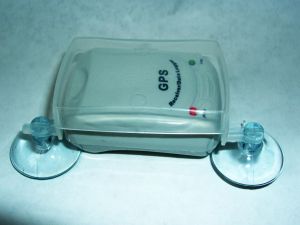
You get a soap box type plastic cover and a number of suction cups that hold the soap box. You then put the receiver inside and plop everything to a window or other smooth surface. It's an acceptable solution but it did make me chuckle. I was also assured that this mounting solution is not provided by default (it just happened to be part of my test package), and if you ask Security Concepts you can actually get a magnetic mount instead.
|